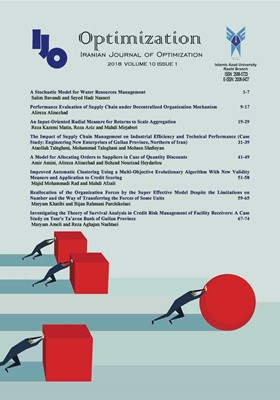Performance Evaluation of Supply Chain under Decentralized Organization Mechanism
محورهای موضوعی : Data Envelopment Analysis
1 - Associate Professor, Department of Industrial Engineering, Faculty of Industrial and Mechanical Engineering, Qazvin branch, Islamic Azad University, Qazvin, Iran
کلید واژه: Supply Chain, Performance Evaluation, Network DEA, Keywords: DEA, decentralized organization mechanism,
چکیده مقاله :
Abstract Nowadays among many evaluation methods, data envelopment analysis has widely used to evaluate the relative performance of a set of Decision Making Units (DMUs). Data Envelopment Analysis (DEA(is a mathematical tool for evaluating the relative efficiency of a set Decision Making Units (DMUs), with multiple inputs and outputs. Traditional DEA models treat with each DMU as a “black box" thus, the performance measurement may be not effective. So, there are necessities for network DEA models. The objective of this paper is to propose a new network DEA model for measuring the efficiency of two- supplier and one manufacturer chains under the decentralized organization mechanism. In this mechanism, each section of supply chain is controlled under unique decision maker with his/her own interest. We proposed that, in comparison with CCR model, for the supply chain under decentralized organization mechanism, it is not appropriate to ignore the internal structure and treat as a “black box”, while there is more than one decision maker with different interests. Furthermore, the relation between the supply chain efficiency and division efficiency is investigated. Numerical example demonstrates the application of the proposed model.
Abstract Nowadays among many evaluation methods, data envelopment analysis has widely used to evaluate the relative performance of a set of Decision Making Units (DMUs). Data Envelopment Analysis (DEA(is a mathematical tool for evaluating the relative efficiency of a set Decision Making Units (DMUs), with multiple inputs and outputs. Traditional DEA models treat with each DMU as a “black box" thus, the performance measurement may be not effective. So, there are necessities for network DEA models. The objective of this paper is to propose a new network DEA model for measuring the efficiency of two- supplier and one manufacturer chains under the decentralized organization mechanism. In this mechanism, each section of supply chain is controlled under unique decision maker with his/her own interest. We proposed that, in comparison with CCR model, for the supply chain under decentralized organization mechanism, it is not appropriate to ignore the internal structure and treat as a “black box”, while there is more than one decision maker with different interests. Furthermore, the relation between the supply chain efficiency and division efficiency is investigated. Numerical example demonstrates the application of the proposed model.
Banker, R.D., Charnes, A., & Cooper, W.W. (1984). Some models for estimating technical and scale inefficiencies in data envelopment analysis, Management Science, 30, 1078–1092.
Beamon, B.M. (1999). Measuring supply chain performance, International Journal of Operations and Production Management, 19 (3), 275–292.
Charnes, A., Cooper, W.W. & Rhodes, E. (1978). Measuring the efficiency of decision making units, European Journal of Operational Research, 2, 429–444.
Chen, C.&Yan, H. (2011). Network DEA model for supply chain performance evaluation, European Journal of Operational Research, 213, 147-155.
Chen, Y.& Zhu, J. (2004). measuring information technology’s indirect impact on firm performance, Information Technology and Management Journal, 5 (1-2), 9-22.
Cooper, W.W.,Seiford, L.M. & Zhu, J. (2004). Data Envelopment Analysis: Models and Interpretations-Handbook on Data Envelopment Analysis, Kluwer, Academic Publisher, Boston.
Fan, M., Stallaert, J., & Whinston, A. B. (2003). Decentralized mechanism design for supply chain organizations using an auction market. Information Systems Research, 14(1), 1-22.
Färe, R.,& Grosskopf, S. (2000). Network DEA. Socio-Economic Planning Sciences, 34, 35–49.
Kao, C. (2009). Efficiency decomposition in network data envelopment analysis: relational model. European Journal of Operational Research, 192 (3), 949–962.
Kao, C. (2009). Efficiency measurement for parallel production systems. European Journal of Operational Research, 196 (3), 1107–1112.
Kao, C., &Hwang, S.N. (2008). Efficiency decomposition in two-stage data envelopment analysis: An application to non-life insurance companies in Taiwan. European Journal of Operational Research, 185 (1), 418–429.
Lewis, H.F. & Sexton, T.R. (2004). Network DEA: Efficiency analysis of organizations with complex internal structure. Computers Operations Research, 31, 1365– 1410.
Liang, L., Yang, F., Cook, W.D., & Zhu, J. (2006). DEA models for supply chain efficiency evaluation. Annuals of Operational Research, 145 (1), 35–49.
Liang, L., Yang, F.,Cook, W. D.,& Zhu, J. (2006). DEA models for supply chain efficiency evaluation. Annuals ofOperational Research, 145(1), 35-49.
Management Science,45 (9), 1270-1288.
Mirhedayatian, S.M.,Azadi, M., &Farzipour Saen, R. (2013). A novel network data envelopment analysis model for evaluation green supply chain management.Int. J. Production Economics.
Seiford, L. M., & Zhu, J. (1999). Profitability and Marketability of the top 55 US commercial banks.
Tone, K., & Tsutsui, M. (2009). Network DEA: A slack-based measure approach. European Journal


